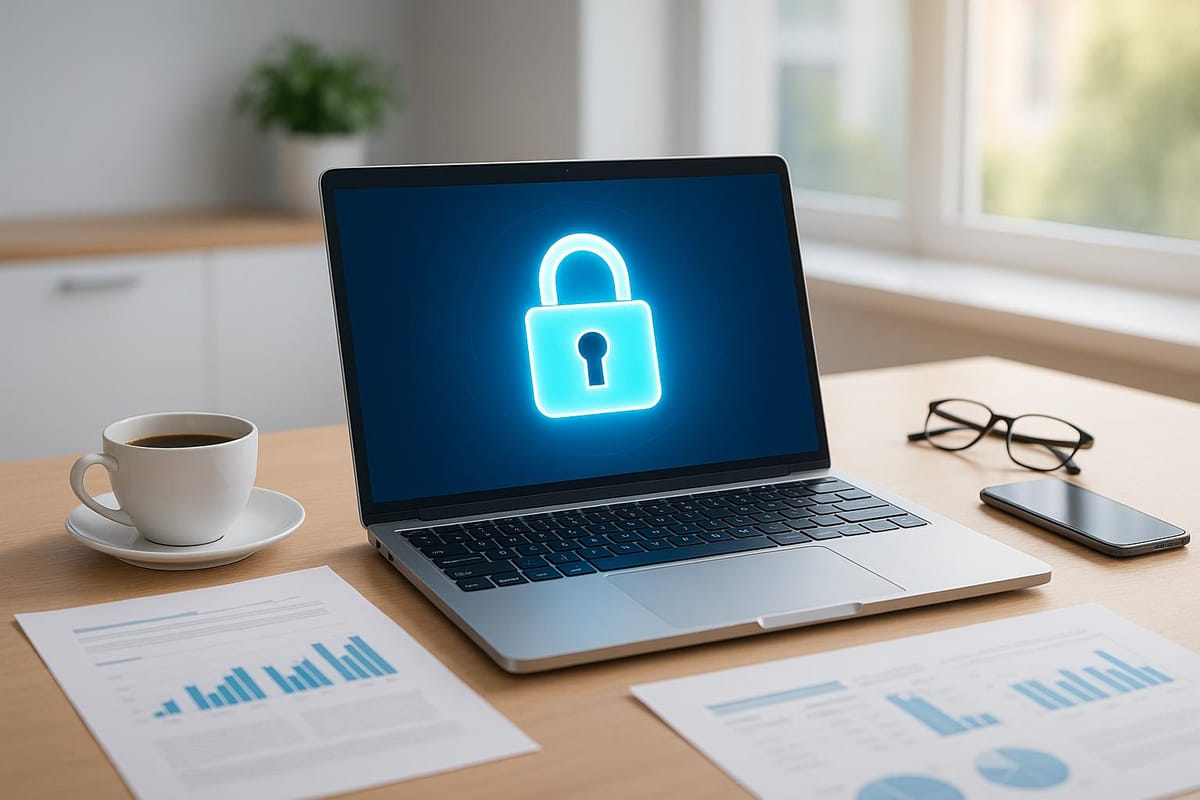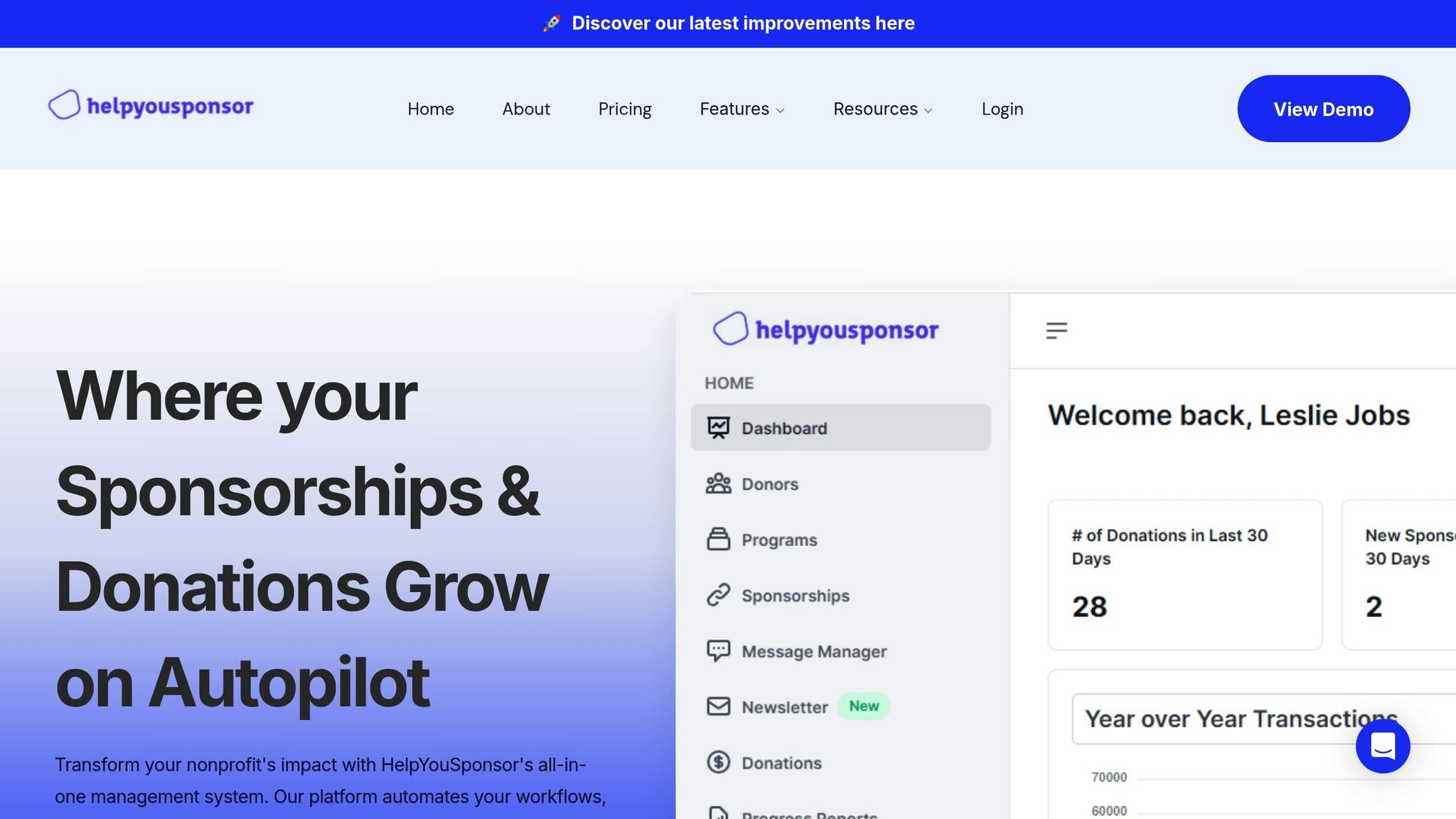Ultimate Guide to Donor Data Security for Nonprofits
Learn essential strategies for nonprofits to protect donor data, maintain trust, and comply with legal standards against rising cybersecurity threats.

Donor data security is critical for nonprofits. Why? Because every donation, volunteer signup, or newsletter subscription involves sensitive personal information. Protecting this data is about more than avoiding breaches - it's about maintaining donor trust, avoiding financial losses, and ensuring compliance with legal standards.
Here’s what you need to know:
- Risks: Nonprofits handle sensitive data (credit card numbers, addresses, donation history) that makes them attractive targets for cybercriminals.
- Threats: 27% of nonprofits have faced cyberattacks, with phishing and internal mistakes being common causes.
- Legal Responsibilities: Compliance with regulations like PCI DSS and breach notification laws is mandatory.
Key Solutions:
- Create a clear privacy policy to explain how donor data is collected and used.
- Limit access to sensitive data with role-based permissions and strong passwords.
- Train staff to recognize threats like phishing and enforce cybersecurity best practices.
- Use donor management software with encryption, two-factor authentication, and compliance tools.
Why it matters: A breach can devastate your nonprofit’s reputation and finances. But with proper strategies, even small organizations can safeguard donor data effectively.
Why Hackers Target Nonprofits - and How to Stop Them
Donor Data Security Risks Nonprofits Face
Understanding the specific risks your nonprofit faces is crucial for creating strong defenses. Nonprofits are increasingly targeted by cybercriminals due to the combination of valuable donor data and limited security resources. Below, we’ll explore the types of data at risk, the cybersecurity threats nonprofits encounter, and the legal responsibilities tied to donor information.
Types of Donor Data Nonprofits Collect
Nonprofits typically gather a wide range of sensitive information. This includes financial details like credit card numbers and bank account information, as well as personal identifiers such as Social Security numbers and birth dates. Many organizations also track giving histories, which can reveal donor wealth, contribution trends, and preferred causes. Additionally, demographic data is often collected to tailor outreach efforts.
Depending on your nonprofit’s mission, the data collected may be even more sensitive. For example, healthcare-focused organizations might store medical records, while nonprofits serving vulnerable populations often maintain highly confidential information. Because donors trust nonprofits with this data, any misuse can have serious consequences. This extensive data collection makes nonprofits attractive targets for identity theft, financial fraud, and unauthorized access to secure accounts.
Common Data Security Threats
Nonprofits face a unique mix of cybersecurity risks, including external attacks and internal vulnerabilities. Social engineering tactics, such as phishing emails, often exploit the trusting nature of nonprofit staff. Alarmingly, 88% of data breaches are linked to internal mistakes. Statistics show that 27% of nonprofits have experienced cyberattacks, and 68% have suffered data breaches in the past three years.
Recent incidents highlight the scale of these threats. In January 2022, Broward Health faced a ransomware attack compromising 1.35 million private records. In 2020, Roots of Peace lost over $1 million to CEO fraud. Major organizations like the International Committee of the Red Cross and Australian Red Cross have also experienced breaches, impacting hundreds of thousands of individuals.
Internal practices often worsen these risks. For instance, 71% of nonprofits allow staff to use unsecured personal devices for work, and 90% lack regular cybersecurity training programs. According to Microsoft's 2021 Digital Defense Report, nonprofits are the second most targeted sector, accounting for 31% of nation-state attack notifications. These vulnerabilities make it essential for nonprofits to understand their legal and ethical obligations.
Legal and Ethical Requirements
Given the rising cybersecurity threats, nonprofits must comply with various regulations. For example, organizations processing credit card payments are required to follow PCI DSS standards. Additionally, state data breach notification laws mandate that affected individuals be informed promptly when their personal information is compromised.
Beyond legal compliance, nonprofits have an ethical duty to protect the sensitive data entrusted to them. The financial consequences of cybercrime are staggering, with global costs projected to exceed $10.5 trillion within the next year. For nonprofits, where 88% of the 1.3 million U.S. charitable organizations operate on annual budgets of $500,000 or less, even a small fraction of these costs can be devastating.
Unfortunately, nonprofits often lack the resources to address these challenges effectively. Over half (56%) of NGOs have no dedicated cybersecurity budget, and 70% report insufficient knowledge and skills to handle cyberattacks. This combination of limited resources and valuable data underscores the urgent need for stronger donor data protection strategies in the nonprofit sector.
Best Practices for Protecting Donor Data
Taking specific steps to safeguard donor data is crucial for maintaining trust and ensuring security. These practices lay the groundwork for a strong data protection strategy, which will be explored further in the following sections.
Creating a Clear Data Privacy Policy
A well-crafted data privacy policy is the foundation of building trust with your donors. This document should clearly outline how your nonprofit gathers, uses, and protects donor information. When done right, it reassures supporters that their data is handled responsibly.
Make sure your privacy policy is easy to find on your website. Be transparent about the types of information you collect, from basic contact details to payment data and donation history. Explain how this information is used - whether it’s for processing donations, sending updates, or analyzing trends to improve your outreach.
Your policy should also address whether donor data is shared or sold to third parties. Include clear contact information and designate a person or department to handle data-related inquiries, giving donors a direct way to ask questions or request changes to their information.
To enhance readability, organize your policy into clearly labeled sections with a table of contents. Avoid complicated legal terms and use straightforward language that anyone can understand. Regularly review and update the policy to reflect any changes in your data practices, and consult a legal expert to ensure compliance with relevant regulations.
Setting Up Data Access Controls
Once your privacy policy is in place, the next step is to limit access to donor data. Not every team member needs full access to all information. By assigning role-based permissions, you can protect sensitive data while allowing staff to perform their duties effectively.
Set up different access levels based on job roles. For example, development staff may need access to donor contact details and giving histories, while event volunteers might only need attendee lists. Strengthen security further by enforcing complex passwords - at least 12 characters long - and enabling two-factor authentication, which requires an additional verification step, like a code sent to a phone.
Conduct regular audits to monitor who has access to donor data. Immediately revoke access for staff who leave the organization or change roles. Many breaches occur when former employees retain access to systems they no longer need. Quarterly audits can help ensure that only current, authorized personnel have access to sensitive information.
Document your access control policies and provide training for all staff. Cover essential topics like sharing login credentials, accessing data from personal devices, and recognizing suspicious activity. Clear guidelines and consistent training reduce the risk of accidental data breaches.
Training Staff on Data Security
Your staff plays a critical role in protecting donor data. With 71% of nonprofits experiencing at least one cybersecurity incident in 2022, investing in staff training is a smart way to prevent breaches.
Start by offering basic cybersecurity training to everyone on your team, including part-time staff and volunteers who interact with donor data. Teach them to recognize common threats like phishing emails and social engineering tactics. Equip them with the knowledge to identify suspicious communications and respond appropriately.
Password security should be a major focus. Train staff to create strong, unique passwords for each system and consider introducing a password manager to simplify this process. Stress the dangers of reusing passwords across platforms and the importance of keeping credentials private.
Incorporate hands-on learning into your training sessions. For example, walk through how to spot a phishing email and practice responding to potential threats. Establish a clear process for reporting suspicious activity so employees know exactly what to do if they encounter a problem. Encourage open communication to ensure staff feel comfortable reporting issues without fear of blame.
Use a mix of training methods, such as online modules, in-person workshops, and simulated phishing tests. Regular reinforcement is key to embedding these practices into your organization's culture. Plan to hold training sessions at least once a year and update the materials as new threats emerge or after any security incidents.
Security Features to Look for in Donor Management Software
When safeguarding donor data, it's crucial to choose donor management software equipped with strong security measures. A reliable system should protect sensitive information not only while it's stored but also during transmission. Below, we break down the essential security features to consider when evaluating your options.
Data Encryption and Secure Storage
Encryption acts as a powerful shield against data breaches. By encoding information so that only a specific key can decode it, encryption ensures that even if someone gains unauthorized access, the data remains unreadable. When assessing donor management software, ask about the encryption protocols it uses for both data at rest and data in transit. Also, verify that it meets relevant legal and regulatory standards.
Two-Factor Authentication
Passwords alone often fall short when it comes to security - studies show that 90% of passwords are weak. Two-factor authentication (2FA) steps in to provide an extra layer of protection. This method combines something you know (like your password) with something you have (such as a phone or security key), significantly reducing the risk of unauthorized access.
To highlight its importance, Microsoft notes:
"Although some web services will prompt you to enable two-factor authentication automatically, you may still need to go to your security settings to do so. Despite the fact that scammers are becoming more adept in their ability to obtain your login credentials, two-factor authentication remains a gold standard, preventing 99 percent of hacker attempts, according to Microsoft."
Look for donor management platforms that support a variety of 2FA methods. Options like authenticator apps or physical security keys offer enhanced protection, especially for accounts handling highly sensitive data. These features are foundational when evaluating how specific systems, such as HelpYouSponsor, implement advanced safeguards.
How HelpYouSponsor Protects Donor Data

HelpYouSponsor safeguards donor information with a multi-layered security approach. By blending top-tier protection with an easy-to-navigate platform, it ensures data security is within reach for nonprofits of all sizes.
Built-In Security Features
HelpYouSponsor employs bank-level encryption to secure donor data both in storage and during transmission. This ensures sensitive information stays protected from unauthorized access. The platform also uses role-based access controls, allowing administrators to assign permissions so only authorized personnel can handle sensitive data. Regular security audits further strengthen the system by identifying and addressing potential vulnerabilities, keeping it resilient against new threats. For payment processing, HelpYouSponsor partners with trusted platforms like Stripe, ensuring donor payment details are managed through secure, well-established channels. Additionally, the platform integrates automated tools to simplify compliance with data regulations.
Automated Compliance Tools
Navigating data privacy regulations can be overwhelming, especially for smaller nonprofits. HelpYouSponsor eases this burden with built-in GDPR tools tailored to nonprofit needs. By automating routine compliance tasks, the platform minimizes administrative work, allowing your team to focus on what matters most - your mission. These tools not only ensure adherence to legal standards but also create a seamless security experience for nonprofits of any size.
Security Solutions Tailored for All Nonprofits
HelpYouSponsor ensures that robust security is available to organizations of every scale. The platform offers flexible pricing plans: Free (up to 10 commitments/month), Pro ($50/month), Growth ($0.80/commitment), and custom Enterprise solutions for nonprofits managing over 500 commitments/month. No matter the plan, users gain access to essential security features like bank-level encryption and role-based access controls. The platform’s user-friendly design, paired with resources like a comprehensive knowledge base, video tutorials, and dedicated customer support, ensures that nonprofits don’t need technical expertise to uphold strong data protection standards.
Maintaining Data Security Over Time
Data security is not a one-and-done effort - it requires constant attention as cyber threats continue to evolve. While we've already covered key practices and features, nonprofits must prioritize long-term security strategies. With 68% of nonprofits lacking documented policies and procedures for cyberattacks, staying ahead of potential risks is essential. Regular evaluations of systems and procedures are a cornerstone of this effort.
Conducting Regular Security Audits
Frequent security audits help pinpoint vulnerabilities and assess the risks associated with donor data. Start with a detailed risk assessment to categorize the types of data your organization handles and evaluate how sensitive that data is. This includes donor contact details, payment information, and other personal data collected during fundraising. Additionally, identify scenarios that could lead to breaches, such as phishing attacks, misplaced devices, or weaknesses in third-party systems.
Annual audits should involve IT teams, legal advisors, and department heads to provide a comprehensive review of donor data risks. These audits ensure your organization stays informed about potential threats and can take timely action to mitigate them.
Creating an Incident Response Plan
If audits uncover vulnerabilities, having a solid incident response plan is critical. Such a plan minimizes damage by enabling quick action, ensuring compliance, and speeding up recovery.
"An incident response plan is a set of instructions to help IT staff detect, respond to, and recover from network security incidents. These types of plans address issues like cybercrime, data loss, and service outages that threaten daily work." – Cisco
Your plan should clearly outline roles and responsibilities, such as assigning an Incident Response Lead, an IT Forensics Specialist, and a Legal Advisor. It should also specify who will manage internal communications, external notifications, and containment efforts. Break the plan into actionable steps for each phase of a breach: detection, containment, notification, and remediation. Be sure to include compliance requirements, like GDPR's 72-hour breach reporting rule, and establish thorough documentation practices to meet regulatory obligations.
Keeping Policies and Practices Current
Security policies must evolve to counter new threats and comply with updated regulations. Currently, 47 states require nonprofits to notify individuals when their personally identifiable information is exposed in a breach.
"In an era of rapidly evolving cyber threats, continuously updating security policies is crucial for organizations to safeguard their assets and information. As new vulnerabilities emerge and sophisticated attack methods develop, static policies can quickly become ineffective - exposing organizations to significant risks." – Hanwha Vision America
Review your security policies annually or whenever major changes occur in your organization, technology, or regulatory landscape. External factors like new data protection laws or emerging global cybersecurity risks may call for immediate updates. Involve key stakeholders - IT, legal, and department leaders - to identify gaps and ensure that policies are practical and actionable.
Employee training plays a major role here. Regular sessions should familiarize staff with updated protocols and provide tools to stay informed about new threats. When employees understand both the "what" and the "why" behind each policy, they’re more likely to follow them. This ongoing focus on education and policy refinement strengthens your organization's overall security posture.
"A commitment to ongoing assessment and refinement of security policies fortifies an organization's defenses, ensuring a resilient posture against the ever-changing landscape of cyber threats." – Hanwha Vision America
Conclusion: Making Donor Data Security a Priority
Protecting donor data isn't just another task on a nonprofit's to-do list - it's a critical responsibility that ensures the organization's longevity and trustworthiness. In this guide, we've covered essential strategies to safeguard donor information, such as implementing strong access controls, using encryption paired with multi-factor authentication, conducting regular security audits, and maintaining an updated incident response plan.
The stakes are high. Data breaches can lead to devastating financial losses, damage to your nonprofit's reputation, and a decline in donor trust - especially for organizations operating on tight budgets. On the flip side, a robust security framework reassures donors that their personal and financial information is in safe hands. This trust is the cornerstone of lasting donor relationships, fostering continued support when donors know their data is managed responsibly.
To bolster your nonprofit's security, focus on core practices: enforce strong passwords, adopt multi-factor authentication, limit access to sensitive data, keep software updated, and provide regular security training for your team. These steps lay a solid foundation for a secure environment.
Platforms like HelpYouSponsor simplify this process by offering built-in encryption, compliance tools, and role-based controls. These integrated solutions demonstrate how nonprofits can adopt best practices without requiring deep technical expertise, making robust security more accessible than ever.
FAQs
What are the biggest cybersecurity threats for nonprofits, and how can they protect against them?
Nonprofits are no strangers to cybersecurity threats. From data breaches and phishing scams to ransomware attacks and insider threats, these risks can jeopardize sensitive donor information and throw operations into chaos.
To stay protected, nonprofits should focus on a few key practices:
- Implement strong password policies and use multi-factor authentication to add an extra layer of security.
- Provide regular training for staff to help them identify phishing attempts and other cyber risks.
- Keep software up to date, ensuring vulnerabilities are patched promptly.
- Perform regular security audits and maintain frequent backups to minimize damage in case of an attack.
By taking these steps, nonprofits can better protect donor data and uphold the trust that is so essential to their mission.
What steps can nonprofits take to comply with legal standards like PCI DSS and data breach notification laws when managing donor data?
Nonprofits can meet PCI DSS requirements and adhere to data breach notification laws by adopting strong data security measures. For PCI DSS compliance, prioritize protecting cardholder information through encryption, regular security assessments, and strict access controls. If your organization handles credit card donations, you might need to complete a self-assessment questionnaire, like SAQ A, particularly when payment processing is handled by a third party.
It's also important to stay updated on state-specific data breach notification regulations. Create an incident response plan to ensure you can promptly inform affected donors if a breach occurs. Taking these steps not only safeguards donor trust but also keeps your organization aligned with legal requirements.
How can nonprofits train their staff to spot and handle cybersecurity threats like phishing?
Training your nonprofit staff to identify and handle cybersecurity threats - like phishing - is a key step in keeping donor data safe. A good starting point is to hold regular training sessions that cover the basics: spotting phishing emails, setting up strong passwords, and knowing how to report anything suspicious.
You can also run simulated phishing campaigns. These exercises let your team practice identifying threats in a controlled setting, helping them build the skills to handle real-world attacks. This hands-on experience reduces the chances of mistakes and boosts their confidence in dealing with potential risks. By blending consistent education with practical training, your staff will be better prepared to protect sensitive data and strengthen your organization’s defenses.

